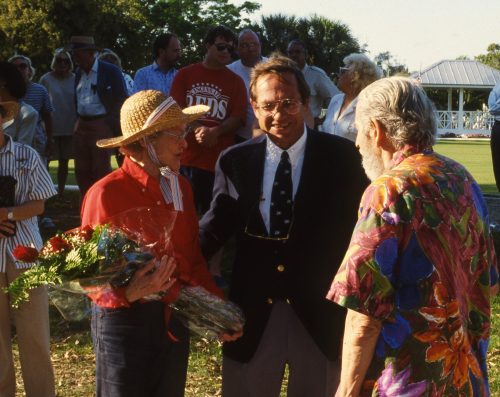Patricia (Pat) Crandon was born in Miami, Florida, at the start of the “Roaring Twenties” on February 12, 1920. Her father, Charles Henry Crandon, a Dade County, Florida, Commissioner from 1929 to 1949, was admired for negotiating, prior to WWII, the gift of over 800 acres of land on Biscayne Key, Miami, to the county for preservation.

A key piece of the negotiation was Commissioner Crandon’s agreement that the county would build a causeway to the island. To finance the causeway Crandon persuaded the DuPont family advisor and financier Ed Ball to purchase $6 million of bonds. The Rickenbacker Causeway to this day connects Miami to Crandon Park and Key Biscayne. Pat’s mother, Agnes Conoly Crandon, was born in Valdosta, Georgia and was both college-educated and a concert pianist.
Pat grew up in Coral Gables, Florida, with one brother, Philip Howland Crandon, thirteen years her junior. She attended Converse College in South Carolina. In 1940, at the age of 20, Pat moved to New York City and became a successful fashion model working with the prestigious Conover Agency.
The “Conover Cover Girls,” as they were known, included the likes of Jane Adams and Eileen Ford. While working in New York, Pat lived in a women’s hotel where men were not permitted above the first fl oor and so gathered in the greeting room awaiting their dates. It was in this greeting room that Pat met thirty-two- year-old Donald Randell, a 1932 graduate of Princeton University in Economic Geology and an army artillery officer. The couple married in 1941 and moved to New Jersey in 1946 following Don’s combat tour of duty with Patton’s army in Europe. Don then worked on Wall Street as an investment analyst.
The Randells’ son, Crandon, was born just prior to Pearl Harbor, followed two years later by daughter Deborah and Frederick (Ricky) in 1948. The family spent twenty-two years in New Jersey and often visited Patricia’s family in Coral Gables, Florida. In September, 1967, Pat and Don drove from New Jersey with their youngest son, Frederick, to Pineland, Florida, and later chose the area as their retirement spot. Ricky, now 62, remembers the land being grown over, with tall weeds covering the mounds and the old house being without running water. The Randells worked the land, transforming it into the “Rocking R Ranch,” with an orange grove, cattle, garden, and a compost pile for kitchen waste. They moved out of the small house into an adjacent stilt house in 1980.
Pine Island resident Phyllis Davis, a neighbor and friend, fondly recalls Pat as a “gracious and kind” woman with a “sense of history, of ecology, of taking care of a special place, and of learning from that place.” With affection, she notes that Pat’s Pineland wardrobe consisted of “Levi slacks, canvas shoes and a straw hat,” and can still picture Pat tending the vegetable garden and picking fruit from trees and then sharing the bounty with friends and neighbors. Phyllis also recalls Pat’s love and affection for her pets, especially her beloved Labrador retrievers.
An artist, writer, and poet at heart, Pat was inspired by the natural landscape and created many written works, needle points, paintings, and ink drawings in tribute to the area. Her “Original Cracker Postcards,” designed in the late 1980s, were created to share the special nature of Florida’s environment, and to evoke in others the captivation she felt for its inhabitants. Sets of the cards were donated to the Pine Island library for sale in a successful fund- raising project. Family and friends still cherish hand-drawn cards created by Pat for holidays and birthdays, including those Pat sent “from the animals” to her grandchildren.
By the 1970s, Pat and Don had pieced together properties that included some of the best preserved and most significant archaeological resources in south- west Florida, including major portions of the Pineland complex and Josslyn Island. Their fi rst donation of land honoring the importance of the area came when they donated land, now known as the Pineland Historic Marker, to Lee County in the 1970s. Although she cherished the tranquility of Pineland, Pat joined with her husband in welcoming archaeologists to their property, and funding excavations both at Josslyn Island and Pineland. It was during the “Year of the Indian” events in 1990 and 1992 that they hosted thousands of visitors, including 5,400 schoolchildren, at excavations taking place literally in their backyard.
Patricia Randell passed away in 2002. She will be remembered for her role in preserving Pineland and the spirit of giving that she embodied. In her honor, the next time you find yourself walking at Pineland, pause for a moment, remember her love for the place, and craft your own verses to her poem “Ode to Pineland” which began, “There once was a place known to me, a fairy-tale spot by the sea …” A fitting tribute it would be, one that would likely bring her a smile.
This article was taken from the Friends of the Randell Research Center Newsletter Vol 9, No. 4. December 2010.